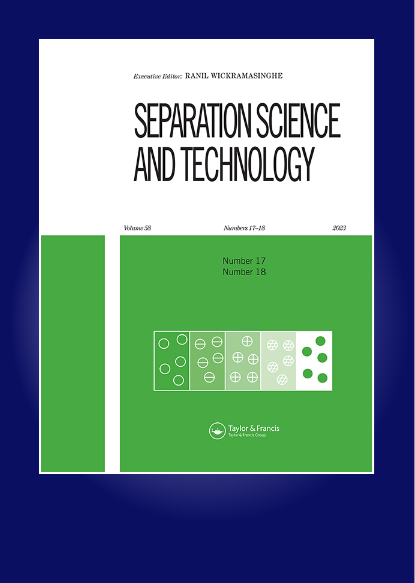T = 298.15 ~ 313.15 K四乙二醇萃取脱硫噻吩及液-液平衡研究
IF 2.3
4区 工程技术
Q3 CHEMISTRY, MULTIDISCIPLINARY
引用次数: 1
摘要
本研究提供了完整的液液平衡(LLE)数据,包括298.15 ~ 313.15 K时庚烷+噻吩+四甘醇和环己烷+噻吩+四甘醇三元混合物在83.4±1 kPa压力下的溶解度曲线和联线。实验数据采用云点法获取。观察到系统的1型相行为。观察到的行为是根据组件之间交互的类型和性质来解释的。通过测定溶质分布系数和选择性,评价了四甘醇萃取脱硫液体燃料中噻吩的性能。高选择性值表明四甘醇是这一目的的良好候选者。研究了温度对双相区面积和分布比的影响,表明萃取过程可以在室温下进行。实验数据成功地与NRTL模型进行了相关。用图形用户界面(GUI)表示吉布斯混合能(GM),验证了相关结果的可靠性。均方根偏差(RMSD)是衡量相关性精度的一种方法,其范围从0.0022到0.0040。本文章由计算机程序翻译,如有差异,请以英文原文为准。
Extractive desulfurization of thiophene by tetraethylene glycol at T = 298.15 to 313.15 K and liquid–liquid phase equilibrium study
ABSTRACT This study provides the complete liquid–liquid equilibrium (LLE) data including the solubility curves and tie-lines for heptane + thiophene + tetraethylene glycol and cyclohexane + thiophene + tetraethylene glycol ternary mixtures at 298.15–313.15 K under a pressure of 83.4 ± 1 kPa. The experimental data were obtained by the cloud point method. Type 1 phase behavior is observed for the systems. The observed behavior was interpreted based on the type and nature of the interactions between the components. The capability of tetraethylene glycol in extractive desulfurization of thiophene from liquid fuel is evaluated by determining the solute distribution coefficient and selectivity. The high values of the selectivity show that tetraethylene glycol is a good candidate for this purpose. The investigation of the effect of temperature on the area of the biphasic region and distribution ratios shows that the extraction process can be performed at room temperature. The experimental data were successfully correlated with the NRTL model. The reliability of the correlation results was checked by using a Graphical User Interface (GUI) for the representation of Gibbs energy of mixing (GM). The root mean square deviation (RMSD), a measure of the precision of the correlations, ranges from 0.0022 to 0.0040.
求助全文
通过发布文献求助,成功后即可免费获取论文全文。
去求助
来源期刊

Separation Science and Technology
工程技术-工程:化工
CiteScore
6.10
自引率
3.60%
发文量
131
审稿时长
5.7 months
期刊介绍:
This international journal deals with fundamental and applied aspects of separation processes related to a number of fields. A wide range of topics are covered in the journal including adsorption, membranes, extraction, distillation, absorption, centrifugation, crystallization, precipitation, reactive separations, hybrid processes, continuous separations, carbon capture, flocculation and magnetic separations. The journal focuses on state of the art preparative separations and theoretical contributions to the field of separation science. Applications include environmental, energy, water, and biotechnology. The journal does not publish analytical separation papers unless they contain new fundamental contributions to the field of separation science.
 求助内容:
求助内容: 应助结果提醒方式:
应助结果提醒方式:


